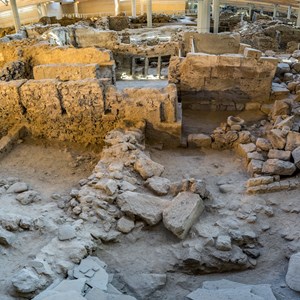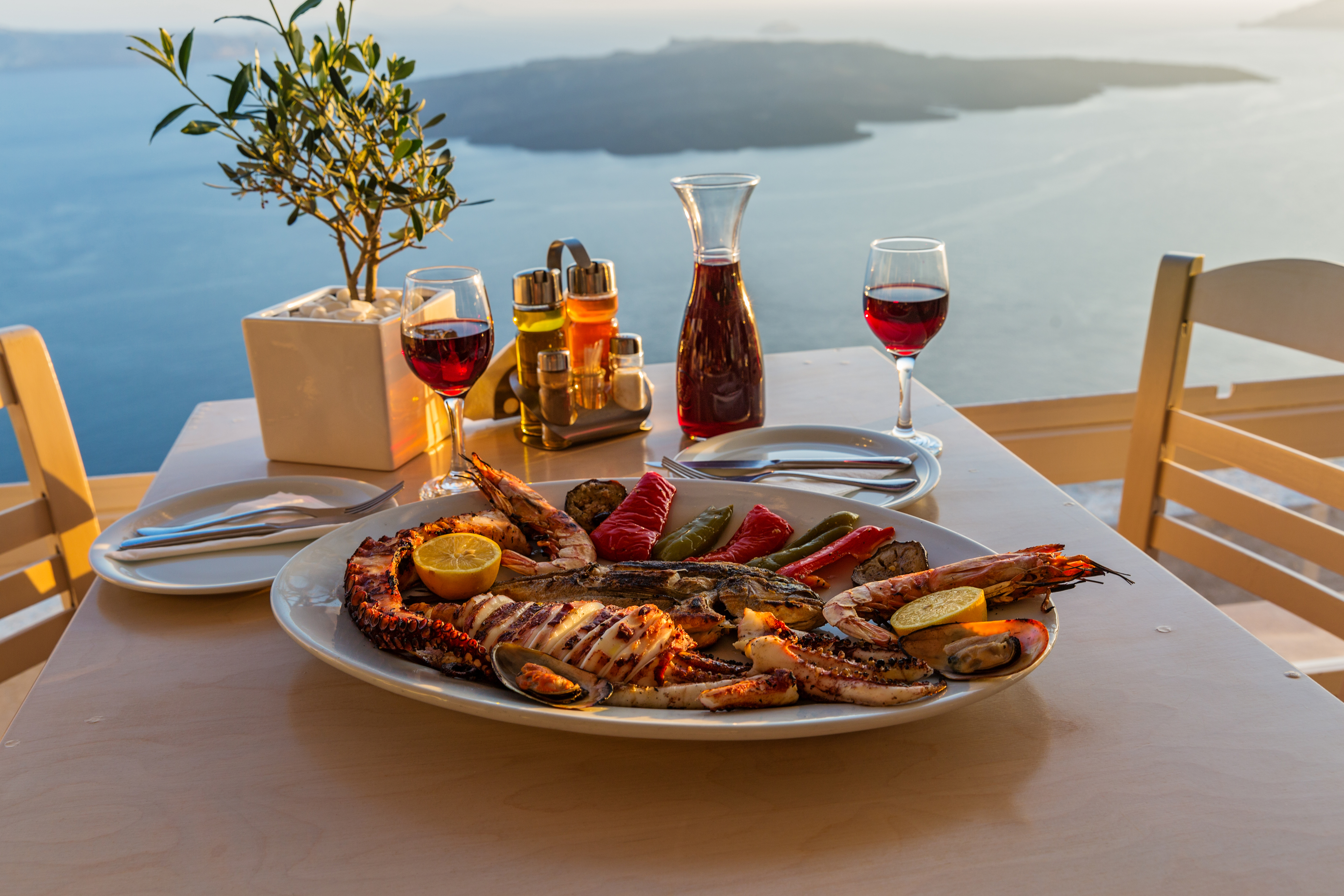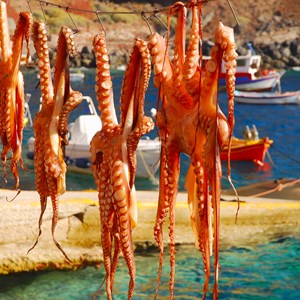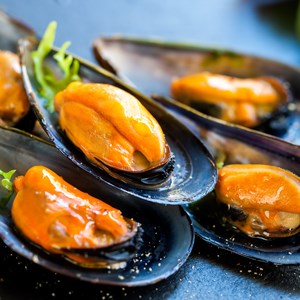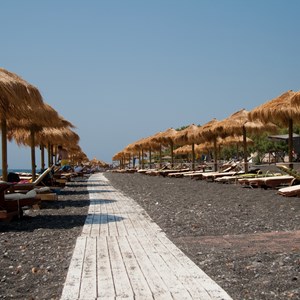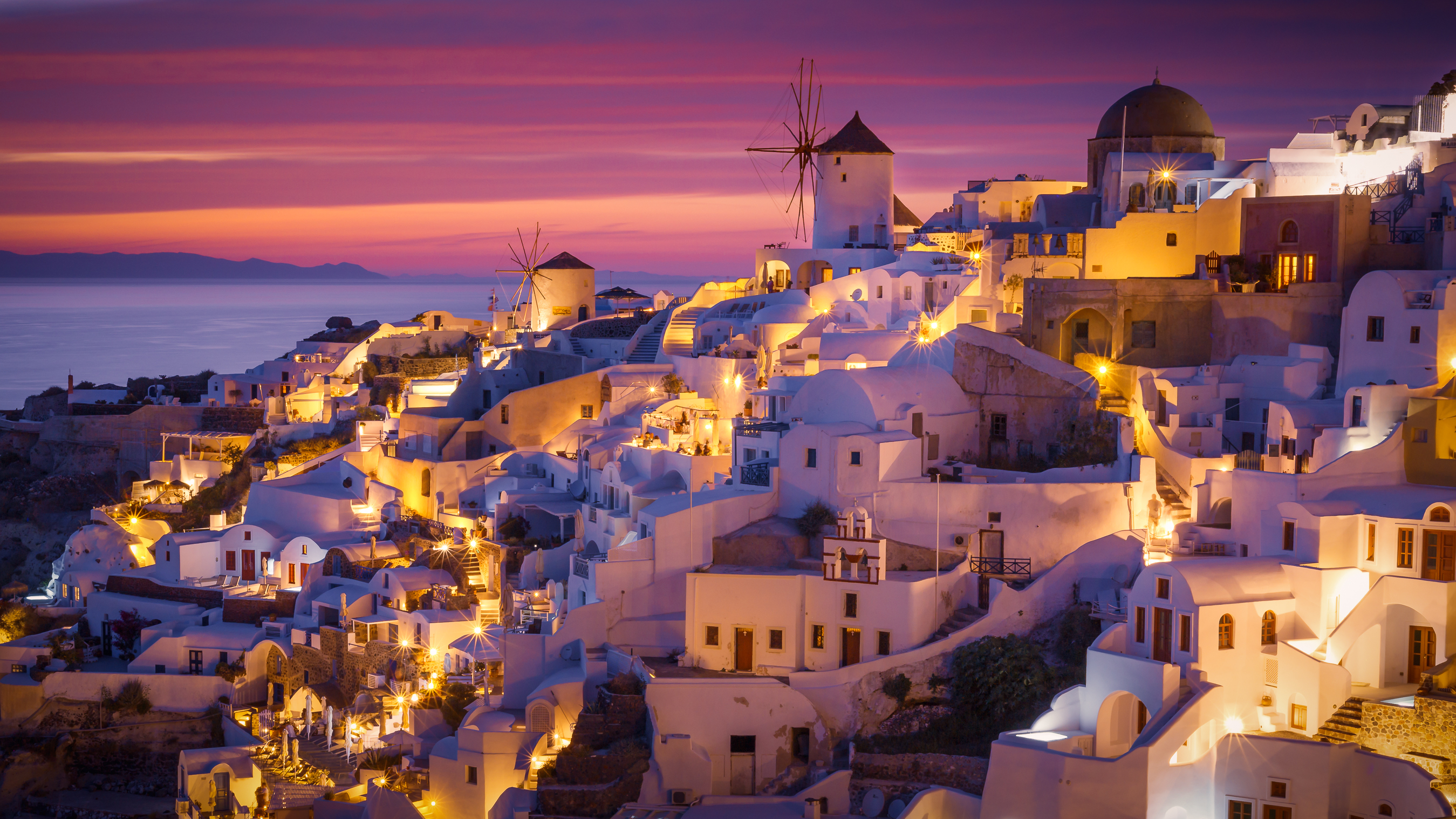

Rising from the deep blue Aegean Sea, Santorini blends its dramatic volcanic cliffs and black-and-red sand beaches with whitewashed houses and blue domes clinging to the caldera. It feels both ancient and dreamlike—quintessentially Greek, but with a twist.
The Island
Santorini's beauty has been celebrated for centuries, fully deserving its ancient epithet 'Kalliste' (the most beautiful). Alongside 'Strogili', these were among the former names given to the island throughout its turbulent history — a history marked by battles and conquests, a devastating volcanic eruption, and a remarkable renaissance. These events left their scars, but never diminished Santorini’s enduring charm.
Together with the inhabited island of Therasia and three smaller islets, Thera (Santorini’s Greek name) forms part of the eponymous archipelago — the remnants of a volcanic caldera. These islands, renowned for their pristine nature and postcard-perfect views, are accessible by boat and offer a glimpse of the timeless appeal of old Santorini.
The main island itself is divided into picturesque villages, expertly adorned in dazzling blue and white hues. These villages reflect the island’s multifaceted personality and extraordinary diversity of landscapes, making Santorini a unique and captivating holiday destination.
Do & See
Santorini is a colourful place which sets the senses alight. The scent of wine grapes and vineyards, the unique taste of tomatoes grown solely on volcanic soil, the smoothness of the white pebbles and turquoise waters, the buzz of nightlife, and the visual art that is the sun setting behind the village of Oia and the caldera. This is a place of colour, flavour, and adventure.
Dining
Without mentioning dazzling panoramas, the mesmerising sea or vibrant villages, Santorini's culinary tradition would be something worth experiencing on its own.
Borrowing a pronounced Mediterranean diet from the mainland, Santorini shares a tendency to use vegetables, high-quality olive oil, meat and fresh seafood generously, creating its own cuisine by adding products that are cultivated solely on its fertile soil.
Try the island's peculiar white eggplant with mozzarella, or sample the unique 'Tomatokeftedes', tomato fritters made of Santorini's own produce, and accompany them beautifully with a glass of Vinsanto. The experience will be matched by an unrivalled view from one of the picturesque taverns the island is studded with.
Most restaurants in Santorini open from April to October, with many closing for the winter—plan ahead if you're visiting off-season.
Cafés
A laid-back attitude accompanies the whole Greek lifestyle, and it is little wonder that it is emphasised even more in Santorini and the Greek Islands. Coffee breaks are a serious matter and a remarkable part of the day, making 'kafeterias' appealing hangouts in suggestive towns.
The most popular version of the traditional coffee is an espresso-like brew that tends to share similarities with Turkish coffee, infused with a sharp flavour, escorting the hearty Greeks throughout the day.
Santorini's scorching sun has led locals and tourists to opt for a more chilled, yet equally efficient option, creating a break ideal for an iced coffee, a frappe, or an ice cream.
Bars & Nightlife
Santorini's nightlife revolves around its bustling capital, a buzzing hub that houses most of the island's foreign-patronised clubs and happening hangouts. The hectic town centre livens up at night, rocking until dawn in a uniform mixture of tourists and locals.
Despite the other villages' less renowned bar scene, Santorini's holiday resorts, having developed substantially around tourism, are certainly not to be underrated. Picturesque bars dot the main drags, often gifting the travellers with breathtaking panoramas.
Shopping
Santorini is in all aspects a work of art, and its souvenirs and local produce doubtlessly reflect the island's beautiful facets. Oia and, above all, Fira are the island's major shopping destinations, places of unrivalled charm where traditional shops line up neatly down narrow streets.
On Santorini, a visit to one of the local art galleries is a must: evocative handicrafts, folk art and jewellery can be bought at accessible prices, guaranteeing a souvenir that mirrors the authenticity of the villages.
Another worthy shopping experience is all about local produce. The diversity of products makes it hard to choose from the numerous delicacies grown on the island's volcanic soil. Fava, the Greek version of split peas, is particularly unique on Santorini, and it is used to make a down-to-earth, yet scrumptious, puree. The island's grapes make a heavenly wine that is exported worldwide and can be bought in any of the local wineries. Last but not least comes Santorini's trademark tomato, the locals' pride and a must-try for food aficionados–wonderfully appetising and juicy.
On Santorini, go for local produce, handicrafts or jewellery–either way, it will be an unmatched experience.
Tourist Information
Santorini Airport (JTR)
Santorini Airport (JTR) is situated approximately 5–6 km southeast of Fira, the island’s capital, making it a convenient entry point for visitors. The journey to Fira typically takes about 10 minutes by car. Travellers have several options to reach the city centre: a public bus service operated by KTEL Santorini runs hourly between the airport and Fira, with a travel time of approximately 10 minutes. Taxis are available outside the terminal, offering a quicker but more expensive ride. Private transfers and hotel-arranged pickups are also common, providing a more personalised service.
While Santorini Airport handles numerous direct flights from major European cities during the summer months, many international travellers may find it more convenient to fly into Athens International Airport (ATH) and then take a short domestic flight (approximately 45 minutes) or a ferry to Santorini, especially during the off-peak season when direct flights are less frequent.
Address: Santorini Airport, Santorini
Email:
Phone: +30 2286 028400
Website: www.jtr-airport.gr/en
More Information:
Passport/Visa
Citizens of the European Union (EU) and European Economic Area (EEA) countries do not need a visa to enter Greece, only a valid ID. Many other countries, including the United Kingdom, the United States, Canada, the United Arab Emirates, Australia, and New Zealand, benefit from visa-free entry for short stays of up to 90 days within a 180-day period.
Visitors from visa-exempt countries must hold a valid passport and, starting in late 2025, will need to apply for an ETIAS (European Travel Information and Authorisation System) authorisation online before travelling.
For those requiring a visa, such as travellers from some Middle Eastern, African or Asian nations, a Schengen visa must be obtained prior to arrival. All travellers should ensure their passport is valid for at least three months beyond their intended stay.
Address:
Email:
Phone:
Website:
More Information:
Donkey Ride
Santorini’s traditional mule rides, where donkeys and mules help carry visitors along the island’s steep paths, particularly between the old port and Fira, remain a visible part of local tourism. However, the practice has drawn criticism from animal welfare groups over the years, raising concerns about the working conditions and overall care of the animals. Travellers are increasingly encouraged to consider alternatives like the cable car or walking, which offer a more ethical and sustainable way to explore the island’s dramatic landscape.
Address: Santorini
Email:
Phone:
Website:
More Information:
Public Transport
Public transport in Santorini is run exclusively by KTEL, with all routes starting or ending in Fira, the island’s central hub. Buses connect popular destinations like Oia, Kamari, Perissa, and Akrotiri, though routes between other villages usually require a change in Fira. Service is more frequent in high season, and tickets are paid in cash on board. While the network covers most of the island, the need to transfer and the irregular schedule on less-visited routes can be a drawback for those short on time.
Address:
Email:
Phone:
Website: www.ktel-santorini.gr/index.php/en
More Information:
Taxi
Taxis in Santorini are limited, especially during peak season, so finding one on the spot can be challenging. While taxis are metered, flat rates often apply for common routes (e.g., airport to Fira), so it's advisable to agree on the fare before the ride.
As of 2025, Uber operates in Santorini, but it works differently than in bigger cities—you’ll be matched with licensed local taxi drivers, not freelance Uber drivers. It’s essentially just a way to book a regular taxi through the app, with a minimum fare that applies no matter the distance. There’s also Uber Boat, which connects some coastal spots by sea.
Many hotels also arrange transfers, which are often more reliable than trying to flag down a taxi, especially late at night or in quieter areas.
Address:
Email:
Phone:
Website:
More Information:
Post
Santorini’s postal services are operated by ELTA (Hellenic Post), easily recognised by their blue and yellow signage. The main post offices are located in Fira, Emporio, and Oia, offering services such as mailing letters and purchasing stamps and postcards. Additionally, postal agencies can be found in Pyrgos, Kamari, and Perissa. Mailboxes are widespread across the island, typically yellow with a blue ELTA logo, and are available in all major villages and resorts.
Address:
Email:
Phone:
Website:
More Information:
Pharmacy
Pharmacies are easy to find in most towns, especially in Fira, Oia, Kamari, and Perissa. Fira has the most options, with several open year-round. Most pharmacists speak English and are helpful with basic medical advice. Opening hours can vary: some close for a midday break (roughly 2pm–5pm), and not all are open on Sundays.
Pharmacy Argyrou Theodora, located near the main square in Fira, is one of the busiest and best-stocked pharmacies on the island.
Address: Pharmacy Argyrou Theodora - Fira's Main Square
Email:
Phone: +30 2286 024501
Website:
More Information:
Telephone
Country code: +30
Area code: 22860
Address:
Email:
Phone:
Website:
More Information:
Electricity
In Greece, the electrical system operates on a voltage of 230 volts with a frequency of 50 hertz. The country primarily uses two types of plugs: type C, which has two round pins, and type F, which also features two round pins with two grounding clips on the sides.
Address:
Email:
Phone:
Website:
More Information:











